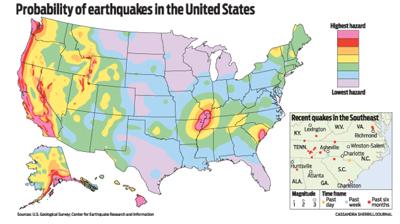The quake was reported around 8:07 a.m., 2.6. miles away from Sparta. According to the United States Geological Survey, the epicenter was 36.8 miles from Boone and 46.1 miles from Lenoir.

It appears to be the strongest North Carolina quake in more than a century, since the 1916 quake that struck near Asheville in Buncombe County. That quake was also probably 5.1 or slightly stronger in magnitude. The Sunday quake is the strongest tremor in the Mid-Atlantic since the 5.8-magnitude event on Aug. 23, 2011, in Mineral, Va.

At first glance, Sunday’s earthquake appears to have originated near the Eastern Tennessee seismic zone, a strip of seismic activity that stretches from the high terrain of eastern Tennessee northeastward up the Appalachians into the Carolinas. At least 5-magnitude or greater quakes have occurred in that pocket since the late 1600s, including near Sparta.

This content is imported from Twitter. You may be able to find the same content in another format, or you may be able to find more information, at their web site.
"We just replaced a 100-year-old water line. So if it had been in the ground, we could have had a lot more damage," Brinegar said.
This aerial view taken on Aug. 9, 2020 shows the site of containment operations for the leaked oil coming from the vessel MV Wakashio, belonging to a Japanese company but Panamanian-flagged, that ran aground near Blue Bay Marine Park off the coast of south-east Mauritius. France on Aug. 8, 2020 dispatched aircraft and technical advisers from Reunion to Mauritius after the prime minister appealed for urgent assistance to contain a worsening oil spill polluting the island nation's famed reefs, lagoons and oceans. Rough seas have hampered efforts to stop fuel leaking from the bulk carrier MV Wakashio, which ran aground two weeks ago, and is staining pristine waters in an ecologically protected marine area. AFP via Getty Images
A 5.1 magnitude earthquake struck North Carolina near the Virginia border on Sunday, with shaking felt as far away as Tennessee and South Carolina. It's the largest quake to hit the state since 1916, the National Weather Service said.
Aftershocks are likely in the coming week. The USGS says that people should “be ready for more earthquakes than usual” as aftershocks “will continue to occur near the mainshock.” In the days leading up to Aug. 16, the agency estimates that the chance of “an earthquake of magnitude 3 or higher is 57%” with as many as 57 occurring. Stronger earthquakes are significantly less likely, the agency says. It suggests that “the chance of an earthquake of magnitude 5 or higher is 5%” and “the chance of an earthquake of magnitude 7 or higher is 1 in 2,000.”
The quake’s epicenter was about 2.5 miles (four kilometers) southeast of Sparta, just south of the Virginia-North Carolina border, the geological survey said. The USGS said the population in the affected region resides in structures “that are resistant to earthquake shaking, though vulnerable structures exist.”
Remembering the 2011 Virginia earthquake that rocked the Eastern U.S.There were some reports of minor damage in the vicinity of Sparta, including of items tossed off shelves at a grocery market and belongings shaken off their perches atop shelves and shattered. Some power outages also were reported.Social media revealed a photo of a home partially damaged.ADADThere were no immediate reports of injuries.Sunday’s quake occurred at a shallow depth estimated at 2.3 miles deep, according to the U.S. Geological Survey (which has been revising this number), amplifying the effects felt on the ground. Earthquake surface waves — the kind that produce the shaking we feel on the ground — travel farther on the East Coast than in the West. That’s because the crust east of the Rockies is less fragmented and more consolidated.A 2.6-magnitude foreshock was registered at 1:57 a.m. near the epicenter of Sunday’s larger tremor.Numerous aftershocks, many of which will be felt in the immediate vicinity of the 5.1-magnitude quake, are likely for upward of a week as the earth continues to settle, shift and release stress.It is highly unlikely, but not impossible, that the 5.1 quake is itself a foreshock of a larger earthquake to come. That was the case in Ridgecrest, Calif., when a 6.4-magnitude quake on July 4, 2019, was followed by a 7.1-magnitude quake the next day.At first glance, Sunday’s earthquake appears to have originated near the Eastern Tennessee seismic zone, a strip of seismic activity that stretches from the high terrain of eastern Tennessee northeastward up the Appalachians into the Carolinas. At least 5-magnitude or greater quakes have occurred in that pocket since the late 1600s, including near Sparta.ADADWhile rumors did briefly circulate on social media, Sunday’s quake did not appear to be associated with hydraulic fracturing, or “fracking.”Initial data suggests the quake was from an oblique reverse-slip event.Reverse faults are fractures in Earth’s crust that occur at an angle. Ordinarily, one block of crust is displaced vertically above the other. The higher fault, known as the “hanging wall,” is forced up the lower “foot wall.” Reverse faults feature the buildup of compressional stress. The Rocky Mountains and Himalayas were formed as a result of reverse fault processes.Thrust faults are a type of reverse fault in which the interface between two blocks of crust is closer to horizontal than it is vertical. That, in essence, causes one plate to slip beneath another.Sometimes, the blocks slip laterally alongside one another while one moves beneath the other. That appears to be the case with Sunday morning’s event, making it an “oblique reverse” slip.Jason Samenow contributed to this article.